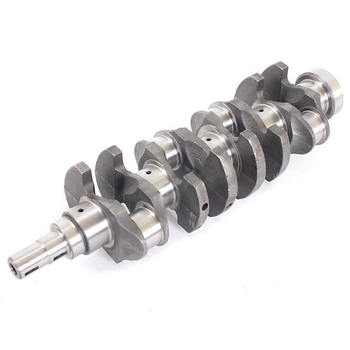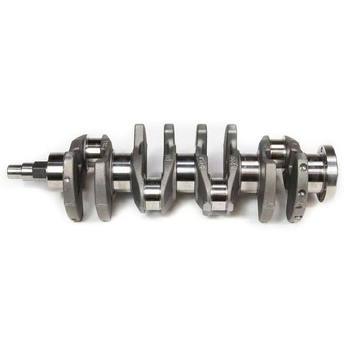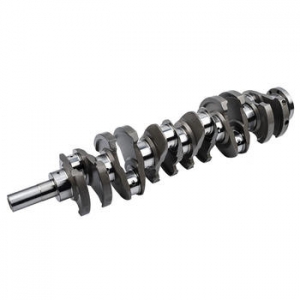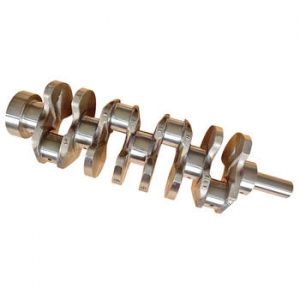The Art and Science of Crankshaft Manufacturing: Powering the World\'s Engines
Introduction: The Unsung Hero of Internal Combustion
Frankly speaking, when we think about what makes an engine tick, our minds often jump to pistons firing, valves opening, or perhaps the roar of the exhaust. But lurking beneath the surface, performing an incredibly vital role, is a component that truly translates the raw power of combustion into rotational motion: the crankshaft. It's the backbone of any internal combustion engine, whether it's in your daily driver, a massive marine vessel, or a powerful industrial machine. Without a perfectly engineered and manufactured crankshaft, the engine simply wouldn't function, or at least not efficiently or reliably.
The process of crankshaft manufacturing is a fascinating blend of traditional metallurgy and cutting-edge precision engineering. It’s a journey that transforms raw metal into a highly complex, incredibly strong, and perfectly balanced component. To be honest, the demands placed on a crankshaft are immense – it must withstand incredible forces, extreme temperatures, and constant rotational stress, all while maintaining precise dimensions. This is why every step in its production is critical, demanding meticulous attention to detail and unwavering quality control.
Have you ever wondered about the sheer complexity involved in creating something so fundamental yet so robust? It’s not just about shaping metal; it's about imbuing it with the properties necessary to endure millions of cycles of intense stress. In my experience, understanding the intricacies of crankshaft manufacturing truly deepens one's appreciation for modern mechanical engineering.
From Raw Material to Robust Design: The Foundation
Material Selection: The Heart of Durability
The journey of a crankshaft begins long before any shaping takes place, with the careful selection of its core material. This choice is paramount, as it dictates the crankshaft's fundamental strength, fatigue resistance, and overall durability. Historically, and still predominantly today, crankshafts are made from either steel alloys or ductile cast iron. Steel alloys, particularly forged steel, are favored for high-performance applications like racing engines or heavy-duty industrial machinery due to their superior strength-to-weight ratio and excellent fatigue resistance. These steels often contain elements like chromium, molybdenum, and nickel, which enhance their mechanical properties.
Ductile cast iron, on the other hand, offers a more cost-effective solution while still providing good strength and vibration damping characteristics. It's commonly used in mass-produced automotive engines. The key here is "ductile," meaning it can deform under stress without fracturing easily, unlike brittle gray cast iron. Interestingly enough, the microstructure of the chosen material, whether it's the refined grain structure of forged steel or the spheroidal graphite nodules in ductile iron, plays a massive role in its performance under dynamic loads.
Many experts agree that the material's ability to resist fatigue is perhaps its most critical property for crankshaft applications. A crankshaft is subjected to millions of load cycles throughout its life, and fatigue failure is a common mode of failure if the material or manufacturing process is subpar. This is why material specifications are incredibly stringent, often involving extensive testing before production even begins.
Design Principles: Engineering for Performance
Once the material is selected, the design phase kicks into high gear. Modern crankshaft design is a sophisticated process, heavily reliant on Computer-Aided Design (CAD) and Computer-Aided Manufacturing (CAM) software. Engineers meticulously design every aspect: the main journals (where the crankshaft rotates in the engine block), the crankpins or rod journals (where the connecting rods attach), the crank webs (connecting the journals and pins), and the counterweights. The counterweights are particularly crucial; they are strategically placed to balance the rotating and reciprocating masses of the engine, minimizing vibrations and ensuring smooth operation.
The geometry of the crankshaft, including fillet radii (the curves where journals meet webs), oil passages, and even the surface finish, is optimized to reduce stress concentrations and ensure proper lubrication. I've found that even a seemingly minor design flaw in these areas can lead to premature failure. Simulation software, such as Finite Element Analysis (FEA), is extensively used to predict stress distribution and identify potential weak points under various operating conditions, allowing designers to refine and optimize the shape before any metal is cut.

The Core Processes of Crankshaft Manufacturing: Forging, Casting, and Machining
With the material and design finalized, the real work of shaping the crankshaft begins. There are two primary methods for initial forming: forging and casting, each with its own advantages. Following this, extensive machining transforms the raw form into a precision component.
Forging: The Hammer's Might
Forging is the preferred method for high-strength crankshafts. It involves shaping metal by applying compressive forces, typically with a hammer or press. The process can be either open-die or closed-die. Open-die forging is used for larger, simpler shapes, while closed-die forging, also known as impression die forging, is more common for crankshafts. In closed-die forging, the heated metal billet is placed into a die cavity shaped like the crankshaft, and immense pressure is applied, forcing the metal to fill the cavity.
The primary advantage of forging is that it refines the grain structure of the metal, aligning it with the shape of the crankshaft. This "grain flow" significantly enhances the component's strength, toughness, and fatigue resistance, making it ideal for applications where extreme loads are expected. Frankly speaking, a forged crankshaft is inherently stronger than a cast one due to this improved internal structure. After forging, the crankshaft "blank" will still be quite rough and require substantial machining.
Casting: Precision in Molten Metal
Casting, primarily using ductile iron, is another widely adopted method, especially for automotive applications due to its cost-effectiveness and ability to produce complex shapes with less material waste and machining. In this process, molten ductile iron is poured into a mold cavity that precisely matches the crankshaft's desired shape. Common casting methods include sand casting and shell molding, which offer good dimensional accuracy and surface finish.
While casting doesn't offer the same grain flow advantages as forging, advancements in metallurgy and casting techniques have significantly improved the strength and reliability of cast crankshafts. They are often lighter than their forged counterparts for similar applications and can be produced with integrated counterweights, reducing subsequent machining steps. The choice between forging and casting for crankshaft manufacturing often comes down to a balance of performance requirements, production volume, and cost.
Machining: Sculpting to Perfection
Regardless of whether the crankshaft blank is forged or cast, the vast majority of its final shape and precision comes from machining. This multi-stage process is where the rough blank is transformed into a component with tolerances measured in micrometers. It begins with rough machining, using turning and milling operations to remove excess material and establish the basic geometry. This is followed by semi-finish machining, bringing the dimensions closer to their final values.
The most critical phase is finish machining. This involves highly precise grinding and polishing operations, particularly for the main journals and crankpins. These surfaces must be incredibly smooth and perfectly round to ensure proper bearing lubrication and minimize friction. Modern precision crankshaft production relies heavily on Computer Numerical Control (CNC) machines, which can execute complex machining paths with unparalleled accuracy and repeatability. These machines are often equipped with in-process gauging to monitor dimensions and adjust cutting parameters in real-time, ensuring consistent quality.
Have you ever considered the precision required to grind a surface to a few micrometers, consistently, across thousands of units? It's a testament to the advancements in machine tool technology. The careful control of temperature, vibration, and cutting fluids during machining is vital to prevent distortion and achieve the desired surface integrity.

Enhancing Performance and Durability: Heat Treatment and Surface Finishing
Once the crankshaft has been machined to its near-final dimensions, it undergoes further processes designed to enhance its mechanical properties, particularly its hardness, wear resistance, and fatigue strength. These steps are crucial for the crankshaft's long-term reliability.
Heat Treatment: Strengthening the Core
Heat treatment processes fundamentally alter the microstructure of the metal, improving its performance characteristics. For crankshafts, common heat treatments include induction hardening and nitriding. Induction hardening involves rapidly heating specific areas of the crankshaft, such as the main journals and crankpins, using electromagnetic induction, followed by rapid quenching. This creates a very hard surface layer (case hardening) while retaining a tougher, more ductile core. This hard surface is highly resistant to wear, which is essential for bearing surfaces.
Nitriding is another popular surface hardening process where nitrogen is diffused into the surface of the steel at elevated temperatures. This creates a very hard, wear-resistant layer that also improves fatigue strength. It's worth noting that the specific heat treatment chosen depends on the material, the design, and the intended application of the crankshaft. These processes are meticulously controlled to achieve the desired depth and hardness of the treated layer, as too much or too little can compromise the crankshaft's integrity.
Surface Finishing: The Final Polish
Beyond heat treatment, several surface finishing operations are performed to optimize the crankshaft's performance and extend its life. Fillet rolling, for instance, is a process where rollers apply compressive stress to the fillet radii (the transitions between journals/pins and webs). This cold working process induces residual compressive stresses in these critical areas, which significantly improves fatigue resistance by counteracting tensile stresses that could lead to crack initiation.
Superfinishing or microfinishing techniques are employed to achieve an exceptionally smooth surface finish on the journals and pins. This ultra-smooth surface reduces friction with the bearings, minimizes wear, and improves oil film retention, all contributing to longer engine life and better efficiency. Frankly speaking, the difference between a good surface finish and an excellent one can mean thousands of extra hours of reliable operation for an engine.
The Critical Step: Balancing and Quality Assurance
Even after all the precise machining and strengthening treatments, a crankshaft isn't ready until it undergoes its final, critical tests: balancing and comprehensive quality control.
Dynamic Balancing: Eliminating Vibrations
This is arguably one of the most crucial steps in engine crankshaft balancing. Even minor imbalances can lead to severe vibrations, excessive wear on bearings, reduced engine efficiency, and ultimately, catastrophic failure. Dynamic balancing machines measure the imbalance at different points along the crankshaft's length while it rotates. Based on these measurements, material is either removed (typically by drilling holes in the counterweights) or added (by attaching balance weights) to achieve perfect rotational balance.
Many experts agree that achieving near-perfect balance is essential for smooth engine operation and longevity. An unbalanced crankshaft can transmit significant forces to the engine block and other components, leading to noise, vibration, and harshness (NVH) issues, and greatly shortening the lifespan of the entire engine assembly. The precision required here is astounding; we're talking about balancing components that spin at thousands of revolutions per minute to within fractions of a gram-millimeter.
Quality Control: Ensuring Flawless Operation
Throughout the entire crankshaft manufacturing process, rigorous quality control (QC) is paramount. This isn't just a final check; it's an ongoing process from raw material inspection to the finished product. Non-destructive testing (NDT) methods are extensively used to detect internal flaws or surface cracks without damaging the component. These include magnetic particle inspection (MPI) for surface cracks, ultrasonic testing (UT) for internal defects, and sometimes eddy current testing for surface and near-surface flaws. Dimensional checks are performed with highly accurate gauges, coordinate measuring machines (CMMs), and optical scanners to ensure every dimension, angle, and surface finish meets the stringent specifications.
I've found that modern QC systems often integrate automation and robotics, allowing for faster, more consistent inspections. Statistical process control (SPC) is also heavily utilized to monitor manufacturing variations and ensure that the process remains within acceptable limits, preventing defects rather than just detecting them. This comprehensive approach to quality assurance is what guarantees the reliability and performance of crankshafts in engines worldwide.

Innovations and the Future of Crankshaft Manufacturing
The field of crankshaft manufacturing is not static; it continues to evolve with new materials, processes, and technologies. One area of significant interest is the potential of additive manufacturing (3D printing) for creating prototypes or even specialized, low-volume crankshafts with complex internal geometries that are impossible to achieve with traditional methods. While not yet viable for mass production due to cost and material property limitations, the research is promising.
Lighter, stronger materials, such as advanced high-strength steels and even composites, are continually being explored to reduce engine weight and improve fuel efficiency. Furthermore, the integration of artificial intelligence (AI) and machine learning into manufacturing processes is leading to "smart factories" where machines can self-optimize, predict maintenance needs, and identify defects with even greater accuracy. Environmental considerations are also driving innovation, with efforts to reduce waste, energy consumption, and the use of hazardous materials in the manufacturing process.
As the automotive industry shifts towards electrification, the demand for traditional internal combustion engine crankshafts may evolve, but the principles of precision engineering, material science, and robust manufacturing will remain critical for other applications, such as industrial power generation, marine propulsion, and even hybrid powertrains. The lessons learned in crafting these vital components will undoubtedly influence future manufacturing paradigms.
Conclusion: The Enduring Legacy of Precision Engineering
The journey of a crankshaft, from a raw billet of metal to a highly polished, perfectly balanced component, is a testament to the incredible advancements in material science, mechanical engineering, and manufacturing technology. It's a process that combines the brute force of forging with the delicate touch of micrometre-level grinding, all underpinned by rigorous quality control.
The precision and durability required for crankshaft manufacturing are truly remarkable. Each step, from material selection and initial design to heat treatment, machining, and final balancing, plays a critical role in ensuring the crankshaft can withstand the immense forces within an engine for millions of cycles. This complex interplay of processes ensures that the unsung hero of the engine continues to reliably convert linear motion into the rotational power that drives our world. It's a continuous pursuit of perfection, embodying the very best of engineering ingenuity.
For more detailed information, please visit our official website:Crankshaft manufacturing
About the author: Dr. Alistair Finch is a distinguished mechanical engineer with over two decades of experience specializing in powertrain components and advanced manufacturing processes. Holding a Ph.D. in Materials Science, his expertise lies in the metallurgy, design, and precision production of critical engine parts, particularly crankshafts. Dr. Finch has consulted for leading automotive and industrial firms, contributing significantly to innovations in durability and performance.
 Trusted Crankshaft company Man
Trusted Crankshaft company Man
 Professional Crankshaft Manufa
Professional Crankshaft Manufa
 Trusted Crankshaft Supplier: W
Trusted Crankshaft Supplier: W
 Trusted Crankshaft Manufacture
Trusted Crankshaft Manufacture
